1984 BMW 7 SERIES ignition
[x] Cancel search: ignitionPage 2 of 14

CRUISE CONTROL WITH ELECTRIC ACTUATOR
The electric actuator type cruise control system was intro-
duced on the BMW 733i and 528e models in 1982. From 1983 all
six-cylinder models will use this type.
The system is designed to operate at between 20 and approximately
90 mph. An electronic control unit (E.C.U.) controls an
electric actuator which maintains the desired road speed via
the throttle linkage.
Driver control is through a three-function switch operated by
a lever mounted on the right side of the steering column be-
hind the wiper lever.
Pushing the lever forward in the CONST position engages the
system and the car will accelerate until the lever is re-
leased. The E.C.U. contains a memory circuit which will hold
the speed that exists when the lever is released from the
CONST. position. Momentary operation of the lever in the CONST.
position will also cause engagement and lock the prevailing
speed into the memory.
Cruise control may be disengaged in any of five different
ways; momentarily moving the control switch up or down to OFF,
applying the foot brake, shifting the automatic transmission to
neutral, depressing the clutch, or whenever the actual speed
drops more than 15 mph below the memory speed.
Following disengagement, the car can be returned to the pre-
viously selected speed by pulling the control lever to RESUME.
The memory circuits in the E.C.U. are reset whenever the
lever is moved to CONST, but the only time the memory is cleared
is when ignition is turned off.
The E.C.U. receives a processed signal from the electronic
speedometer, which is equivalent to actual road speed. Con-
sequently, speedometer problems will affect cruise control.
Page 4 of 14
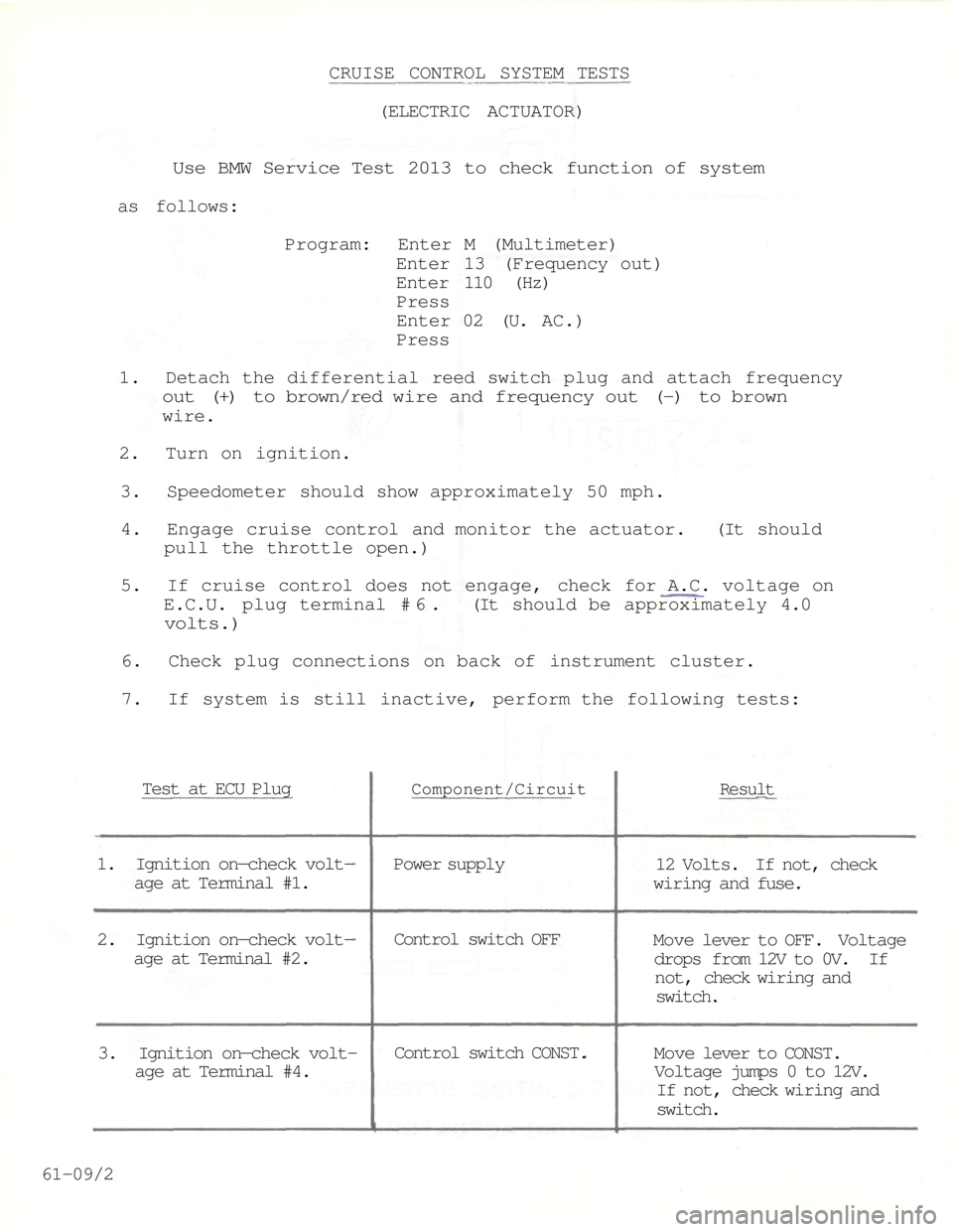
CRUISE CONTROL SYSTEM TESTS
(ELECTRIC ACTUATOR)
Use BMW Service Test 2013 to check function of system
as follows:
Program: Enter M (Multimeter)
Enter 13 (Frequency out)
Enter 110 (Hz)
Press
Enter 02 (U. AC.)
Press
1. Detach the differential reed switch plug and attach frequency
out (+) to brown/red wire and frequency out (-) to brown
wire.
2. Turn on ignition.
3. Speedometer should show approximately 50 mph.
4. Engage cruise control and monitor the actuator. (It should
pull the throttle open.)
5. If cruise control does not engage, check for A.C. voltage on
E.C.U. plug terminal #6. (It should be approximately 4.0
volts.)
6. Check plug connections on back of instrument cluster.
7. If system is still inactive, perform the following tests:
Test at ECU Plug
Component/Circuit
Result
1. Ignition on—check volt-
age at Terminal #1.
Power supply
12 Volts. If not, check
wiring and fuse.
2. Ignition on—check volt-
age at Terminal #2.
Control switch OFF
Move lever to OFF. Voltage
drops from 12V to 0V. If
not, check wiring and
switch.
3. Ignition on—check volt-
age at Terminal #4.
Control switch CONST.
Move lever to CONST.
Voltage jumps 0 to 12V.
If not, check wiring and
switch.
61-09/2
Page 5 of 14
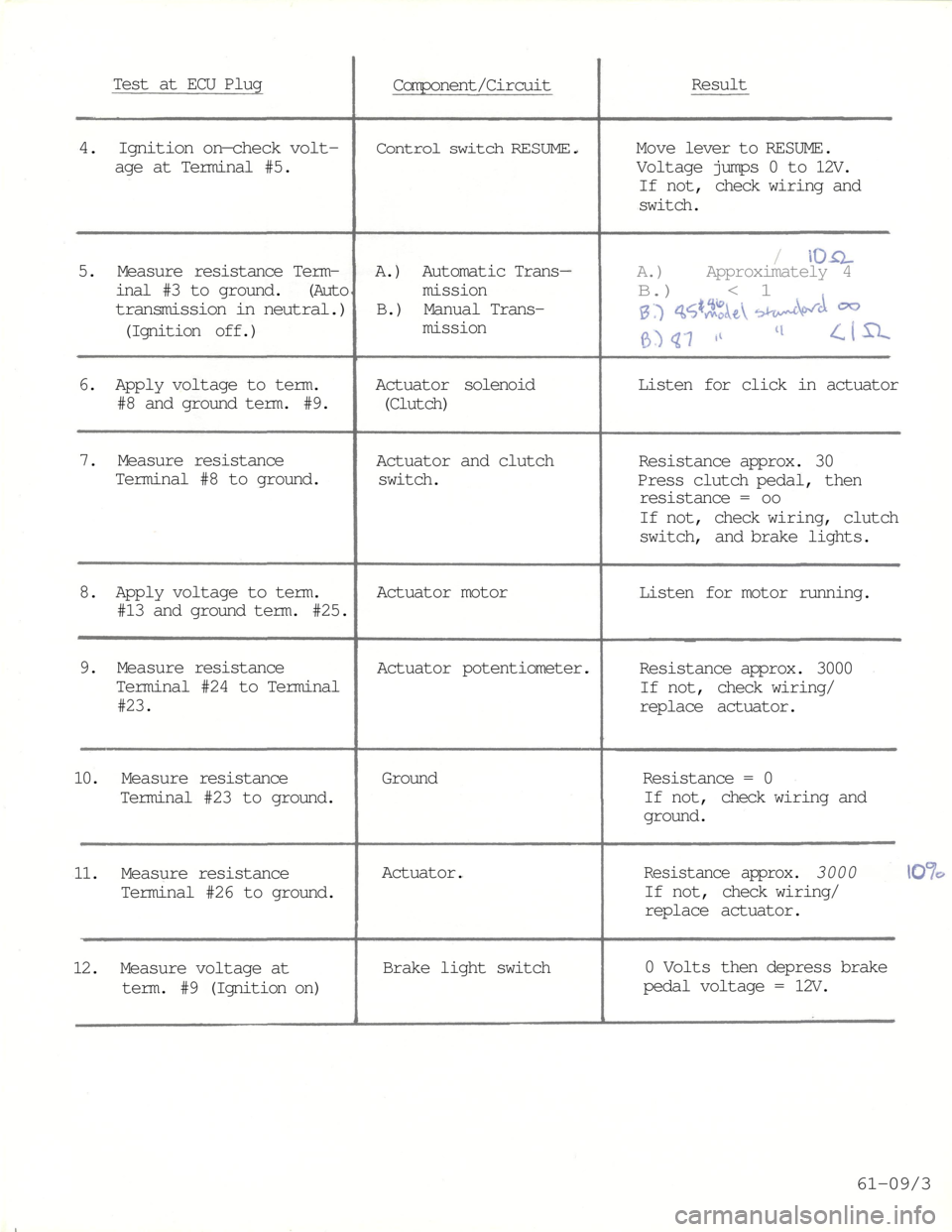
Test at ECU Plug
Component/Circuit
Result
4. Ignition on—check volt-
age at Terminal #5.
Control switch RESUME.
Move lever to RESUME.
Voltage jumps 0 to 12V.
If not, check wiring and
switch.
5. Measure resistance Term-
inal #3 to ground. (Auto
transmission in neutral.)
(Ignition off.)
A.) Automatic Trans-
mission
B.) Manual Trans-
mission
A.) Approximately 4
B.) < 1
6. Apply voltage to term.
#8 and ground term. #9.
Actuator solenoid
(Clutch)
Listen for click in actuator
7. Measure resistance
Terminal #8 to ground.
Actuator and clutch
switch.
Resistance approx. 30
Press clutch pedal, then
resistance = oo
If not, check wiring, clutch
switch, and brake lights.
8. Apply voltage to term.
#13 and ground term. #25.
Actuator motor
Listen for motor running.
9. Measure resistance
Terminal #24 to Terminal
#23.
Actuator potentiometer.
Resistance approx. 3000
If not, check wiring/
replace actuator.
10. Measure resistance
Terminal #23 to ground.
Ground
Resistance = 0
If not, check wiring and
ground.
11. Measure resistance
Terminal #26 to ground.
Actuator.
Resistance approx. 3000
If not, check wiring/
replace actuator.
12. Measure voltage at
term. #9 (Ignition on)
Brake light switch
0 Volts then depress brake
pedal voltage = 12V.
61-09/3
Page 8 of 14

CRUISE CONTROL
The BMW cruise control is designed to operate between 20
and approximately 90 mph. An electronic control unit (E.C.U.)
controls a vacuum operated servo unit which actuates the
throttle linkage to maintain the required road speed.
Drive control is through a three function switch operated
by a lever mounted on the right side of the steering column
behind the wiper lever.
Pushing the lever forward in the CONST position engages the
system and the car will accelerate until the lever is
released. The E.C.U. contains a memory circuit which will
hold the speed that exists when the lever is released from
the CONST position. Momentary operation of the lever in the
CONST position will also cause engagement and lock the
prevailing speed into the memory.
Cruise control may be disengaged in any of five different
ways: momentarily moving the control switch up or down to
OFF, applying the foot brake, shifting the transmission to
neutral, or whenever the actual speed drops more than 7 mph
below the memory speed.
Following disengagement, the car can be returned to the
previously selected speed by pulling the control lever to
RESUME.
The memory circuits in the E.C.U. are reset whenever the
lever is moved to CONST but the only time the memory is
cleared is when ignition is turned off.
Page 10 of 14
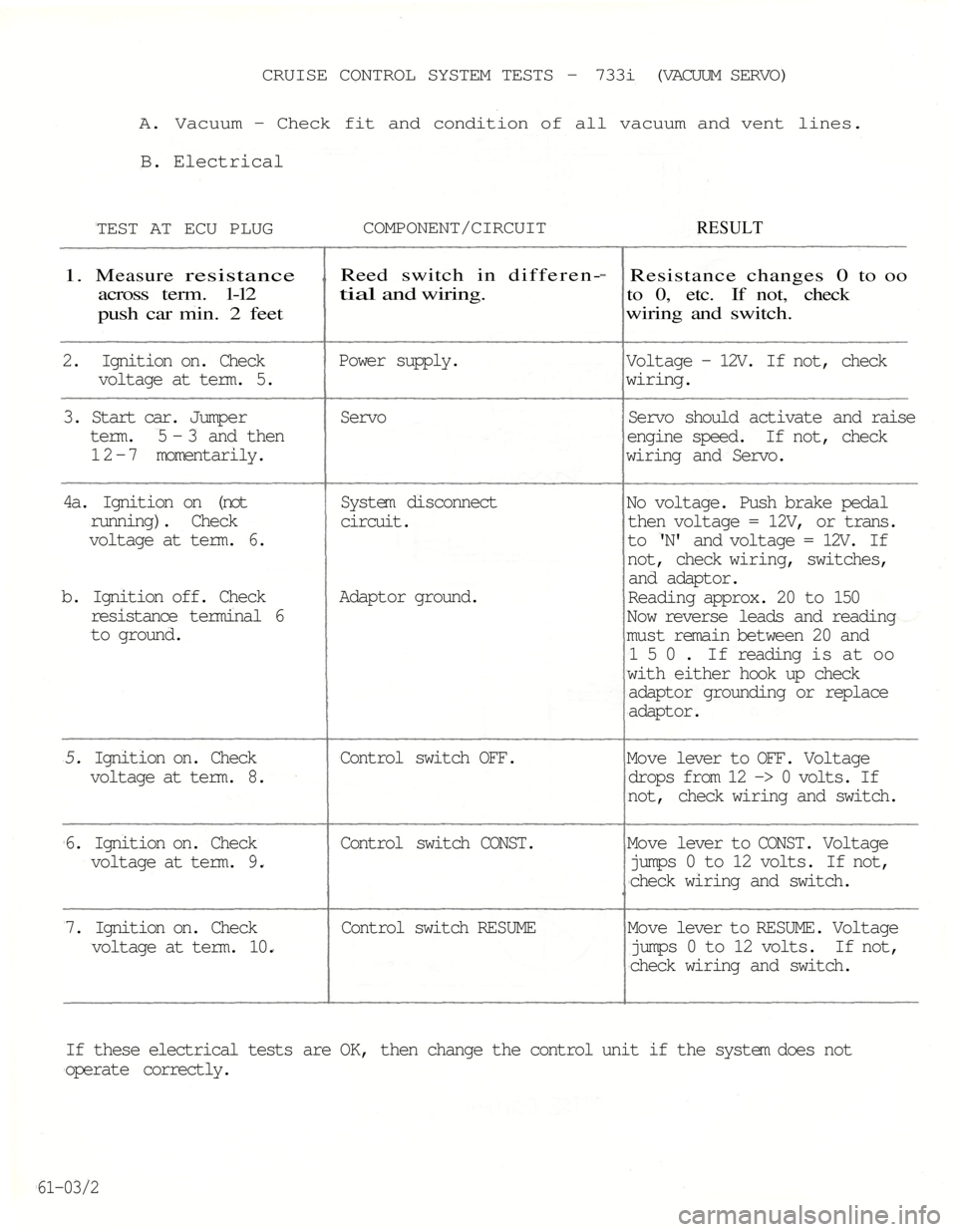
CRUISE CONTROL SYSTEM TESTS - 733i (VACUUM SERVO)
A. Vacuum - Check fit and condition of all vacuum and vent lines.
B. Electrical
TEST AT ECU PLUG
COMPONENT/CIRCUIT
RESULT
1.
Measure
resistance
across term. 1-12
push car min. 2 feet
Reed switch in differen-
tial
and
wiring.
Resistance changes 0 to oo
to 0, etc. If not, check
wiring and switch.
2. Ignition on. Check
voltage at term. 5.
Power supply.
Voltage - 12V. If not, check
wiring.
3. Start car. Jumper
term. 5-3 and then
12-7 momentarily.
Servo
Servo should activate and raise
engine speed. If not, check
wiring and Servo.
4a. Ignition on (not
running). Check
voltage at term. 6.
b. Ignition off. Check
resistance terminal 6
to ground.
System disconnect
circuit.
Adaptor ground.
No voltage. Push brake pedal
then voltage = 12V, or trans.
to 'N' and voltage = 12V. If
not, check wiring, switches,
and adaptor.
Reading approx. 20 to 150
Now reverse leads and reading
must remain between 20 and
150. If reading is at oo
with either hook up check
adaptor grounding or replace
adaptor.
5. Ignition on. Check
voltage at term. 8.
Control switch OFF.
Move lever to OFF. Voltage
drops from 12 -> 0 volts. If
not, check wiring and switch.
6. Ignition on. Check
voltage at term. 9.
Control switch CONST.
Move lever to CONST. Voltage
jumps 0 to 12 volts. If not,
check wiring and switch.
7. Ignition on. Check
voltage at term. 10.
Control switch RESUME
Move lever to RESUME. Voltage
jumps 0 to 12 volts. If not,
check wiring and switch.
If these electrical tests are OK, then change the control unit if the system does not
operate correctly.
61-03/2
Page 11 of 14
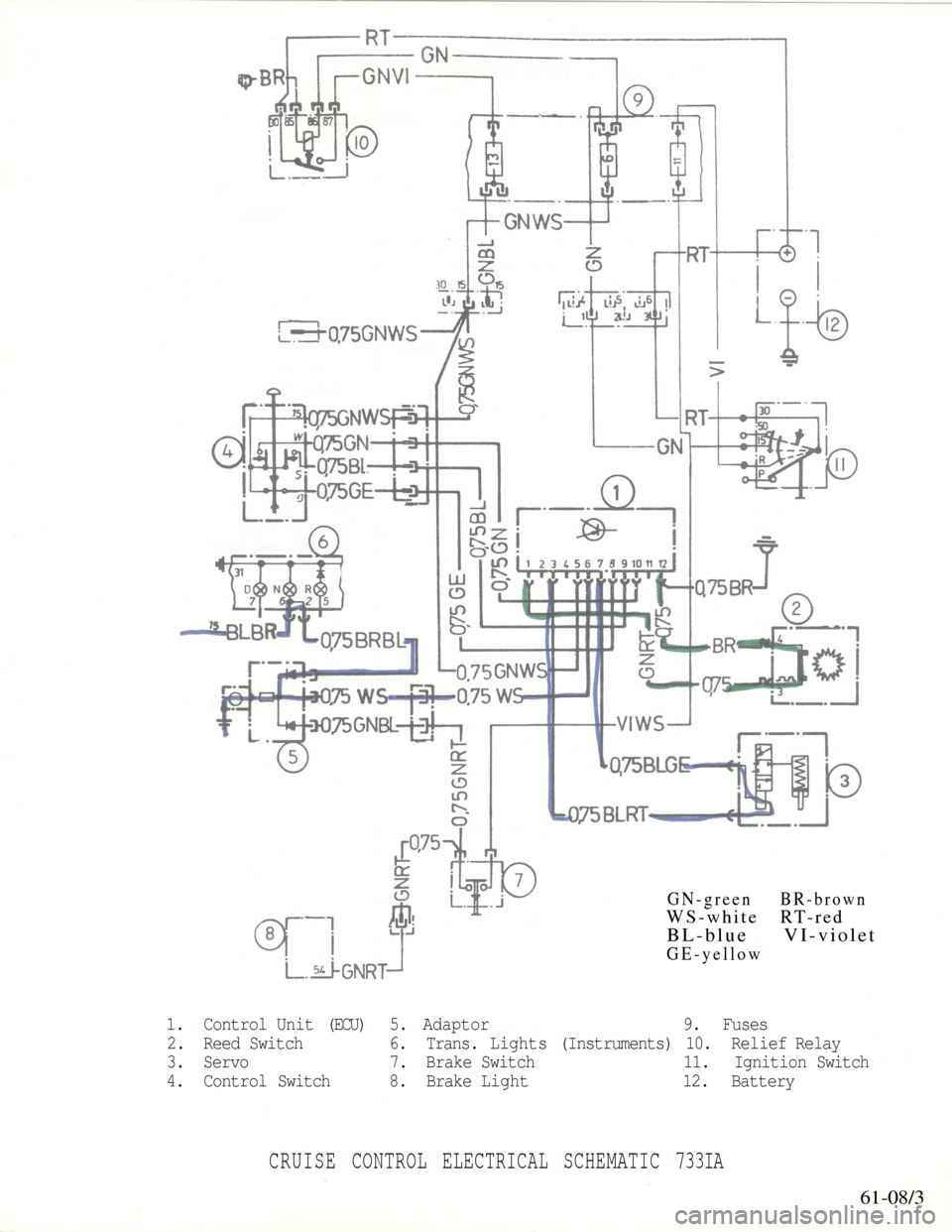
CRUISE CONTROL ELECTRICAL SCHEMATIC 733IA
61-08/3
GN-green BR-brown
WS-white RT-red
BL-blue VI-violet
GE-yellow
1. Control Unit (ECU) 5. Adaptor 9. Fuses
2. Reed Switch 6. Trans. Lights (Instruments) 10. Relief Relay
3. Servo 7. Brake Switch 11. Ignition Switch
4. Control Switch 8. Brake Light 12. Battery
Page 12 of 14
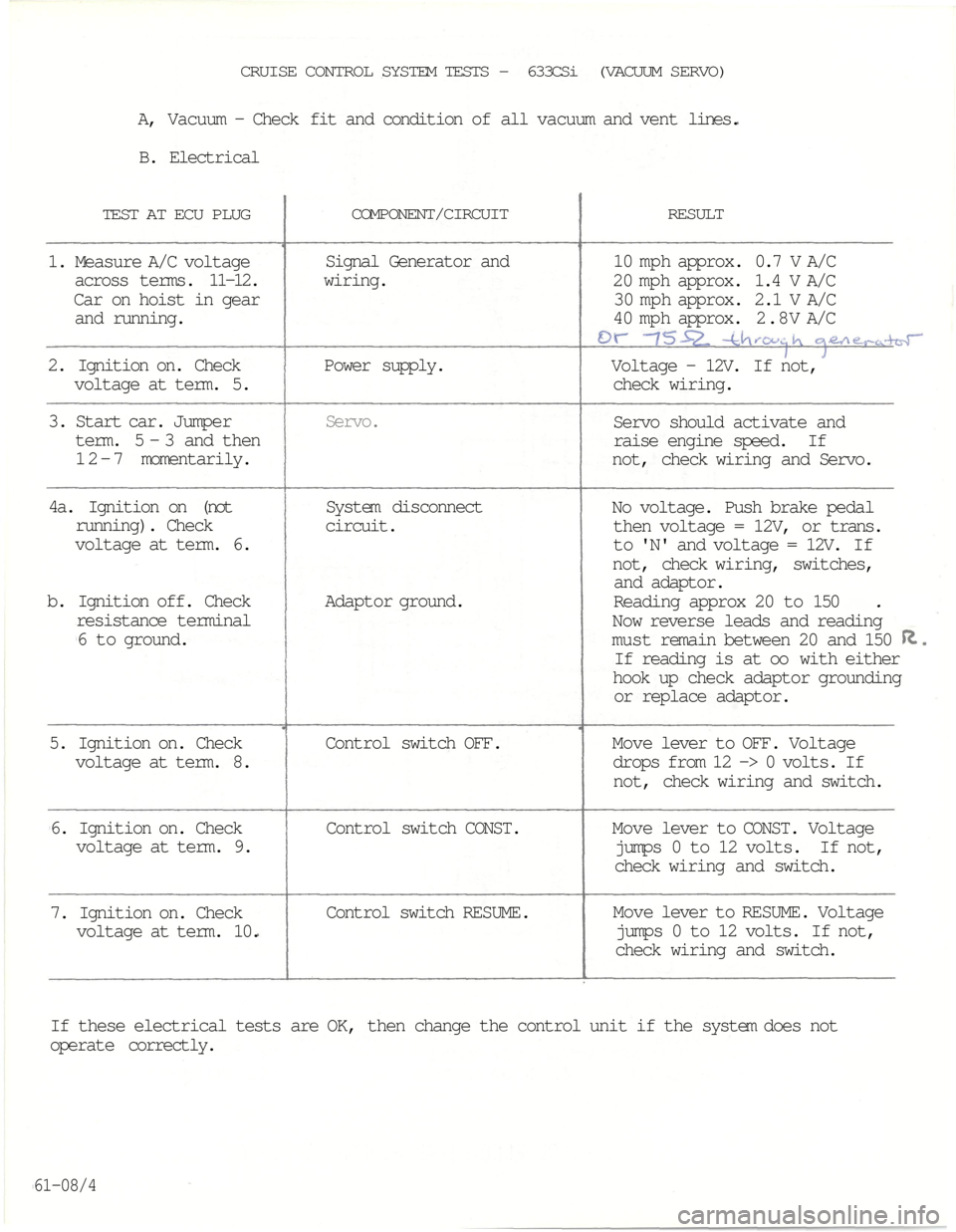
CRUISE CONTROL SYSTEM TESTS - 633CSi (VACUUM SERVO)
A, Vacuum - Check fit and condition of all vacuum and vent lines.
B. Electrical
TEST AT ECU PLUG
COMPONENT/CIRCUIT
RESULT
1. Measure A/C voltage
across terms. 11-12.
Car on hoist in gear
and running.
Signal Generator and
wiring.
10 mph approx. 0.7 V A/C
20 mph approx. 1.4 V A/C
30 mph approx. 2.1 V A/C
40 mph approx. 2.8V A/C
2. Ignition on. Check
voltage at term. 5.
Power supply.
Voltage - 12V. If not,
check wiring.
3. Start car. Jumper
term. 5-3 and then
12-7 momentarily.
Servo.
Servo should activate and
raise engine speed. If
not, check wiring and Servo.
4a. Ignition on (not
running). Check
voltage at term. 6.
b. Ignition off. Check
resistance terminal
6 to ground.
System disconnect
circuit.
Adaptor ground.
No voltage. Push brake pedal
then voltage = 12V, or trans.
to 'N' and voltage = 12V. If
not, check wiring, switches,
and adaptor.
Reading approx 20 to 150 .
Now reverse leads and reading
must remain between 20 and 150
If reading is at oo with either
hook up check adaptor grounding
or replace adaptor.
5. Ignition on. Check
voltage at term. 8.
Control switch OFF.
Move lever to OFF. Voltage
drops from 12 -> 0 volts. If
not, check wiring and switch.
6. Ignition on. Check
voltage at term. 9.
Control switch CONST.
Move lever to CONST. Voltage
jumps 0 to 12 volts. If not,
check wiring and switch.
7. Ignition on. Check
voltage at term. 10.
Control switch RESUME.
Move lever to RESUME. Voltage
jumps 0 to 12 volts. If not,
check wiring and switch.
If these electrical tests are OK, then change the control unit if the system does not
operate correctly.
61-08/4
Page 13 of 14

CRUISE CONTROL ELECTRICAL SCHEMATIC 633CSiA
61-08/5
1. Control Unit (ECU) 5. Control Switch 9. Fuses
2. Signal Generator 6. Battery 10. Relief Relay
3. Ignition Switch 7. Adaptor 11. Brake Light
4. Servo 8. Trans. Lights 12. Brake Switch
GN-green BR-brown
WS-white RT-red
BL-blue VI-violet
GE-yellow